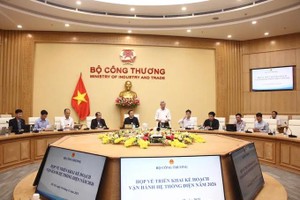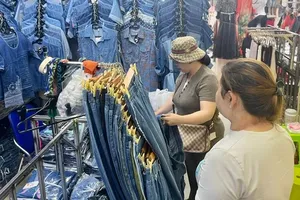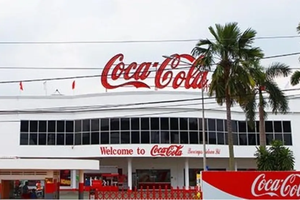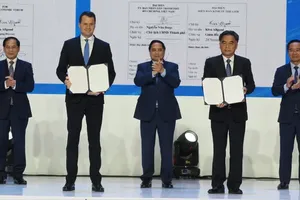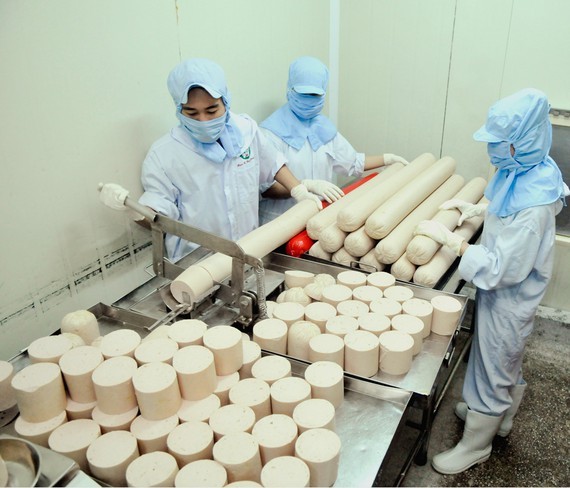 Commercial banks are currently directing credit capital flows into priority manufacturing and business sectors. (Photo: SGGP)
Commercial banks are currently directing credit capital flows into priority manufacturing and business sectors. (Photo: SGGP)
Many banks ask to loosen the credit room The credit room assigned by the SBV to credit institutions at the beginning of the year is based on the scale, asset quality, and actual credit growth of each bank. Accordingly, there are commercial banks that receive the highest credit room of 12 percent, but there are also commercial banks that receive a credit room of 6-8 percent. Meanwhile, many banks often set a credit growth target of 20-30 percent because the SBV will usually consider granting a second credit limit to commercial banks in the last months of the year when the demand for capital climbs. In the first six months of this year, thanks to economic recovery and a favorable real estate market, credit growth doubled compared to the same period last year. Hence, many banks have used up most of their credit room. As a State-owned commercial bank that receives the highest credit room in the Big Four - the group of four largest State-owned commercial banks - at 10.5 percent, but in the first six months of the year, Vietcombank's credit rose by 9 percent, nearly twice the average of the banking industry. TPBank has posted credit growth at nearly 7 percent, while its full-year credit limit is 11.5 percent. ACB has also nearly touched the granted credit room to 9.5 percent. Other commercial banks, such as MBBank, in the first quarter of this year alone, achieved credit growth of 8.6 percent, close to its credit limit of 10.5 percent. In the first three months of this year, Techcombank achieved a credit growth of 6.76 percent in a 12 percent credit room. MSB ended the first quarter with credit growth of 9.5 percent within the assigned limit of more than 10 percent. With the credit room nearly reaching the ceiling in the first few months of the year, many commercial banks have rushed to increase charter capital to create a basis for the SBV to consider loosening the credit room because a successful capital increase will help banks improve the index of financial safety and have more space for credit growth. Currently, more than ten commercial banks have run out of credit room and are asking the SBV for more. In a recent meeting with the Government, the SBV said that it was considering expanding the credit room for commercial banks to ensure the quality of credit growth, as well as to meet the capital demand of the economy. Regarding the imposition of annual credit room for commercial banks, there are many different opinions. Some experts said that this is an administrative tool. Instead, depending on the capital adequacy ratio (CAR), loan-to-deposit ratio, and short-term capital ratio for medium and long-term loans, each commercial bank will adjust its credit growth according to its business ability. Besides, the allocation of the credit limit for each bank can affect interest rates, especially loan interest rates, because once banks run out of room, it will lead to lending restrictions and interest rate hikes while waiting for the SBV’s consideration. But experts of the Economic Research Center of Maritime Bank said that at present, an important requirement of the Government is macro stability. Therefore, first of all, it is necessary to stabilize the financial and monetary market. Credit room is one of the effective tools for the SBV to stabilize the money market. Vietnam's economy relies mainly on credit, equivalent to about 140 percent of gross domestic product. If credit growth is not controlled, bad debts will possibly increase, causing macro instability. Mr. Pham Thanh Ha, Director of SBV Monetary Policy Department, said that credit management by targets and orientations is necessary. It has shown efficiency for many years in both inflation control and credit quality. Therefore, in 2021, the SBV will continue to operate credit targets in line with macroeconomic developments.Preferential treatment for customers affected by Covid-19 Facing the proposal of commercial banks, according to experts, besides using business activities and bad debt ratio of banks as a basis, the SBV should prioritize loosening room for commercial banks that focus capital on priority manufacturing and business sectors. Banks that give too many loans to potentially risky sectors and have not made provision for bad debts sufficiently should be carefully considered. Commercial banks are currently directing credit capital flows into priority manufacturing and business sectors. Specifically, from July 1, Agribank will spend VND15 trillion and US$300 million for individual and corporate customers to borrow capital for production, business, import, and export activities at low-interest rates from 1.7 percent per annum for loans in USD and 3.5 percent per annum for loans in VND. Agribank also offers many incentives on foreign currency exchange rates and reduces or exempts fees for import and export letters of credit The nationwide program lasts until June 30, 2022, or until the fund for the program runs out. At the same time, Agribank also implemented many other preferential credit programs, with a scale of more than VND170 trillion for customers affected by the Covid-19 pandemic, small and medium-sized enterprises, and FDI enterprises. VietCapital Bank has launched a loan package of VND9 trillion with interest rates down by up to 2 percent, especially for small and medium-sized enterprises, with simple procedures. Sacombank has had a credit package of VND10 trillion to support export enterprises and enterprises to overcome difficulties in production and business activities from now until the end of this year with an interest rate of 4-6.7 percent per annum. From now until the end of September 30, VPBank will also promote an unsecured loan package with a credit limit of up to VND3 billion, lowering lending interest rates for small and medium-sized enterprises by 0.5-2 percent per annum. ABBank raised the total preferential loan limit for businesses to VND3 trillion, with an interest rate from 4.4 percent or support for small and medium-sized enterprises with an interest rate from 5.9 percent per annum until the end of September this year.
SBV Deputy Governor Dao Minh Tu said that in the future, it is possible to consider removing the mechanism of credit room with the condition that medium and long-term capital is mainly mobilized through the financial, securities, and capital markets instead of the monetary market. Then, commercial banks do not have to mobilize short-term capital for medium and long-term loans as currently.

